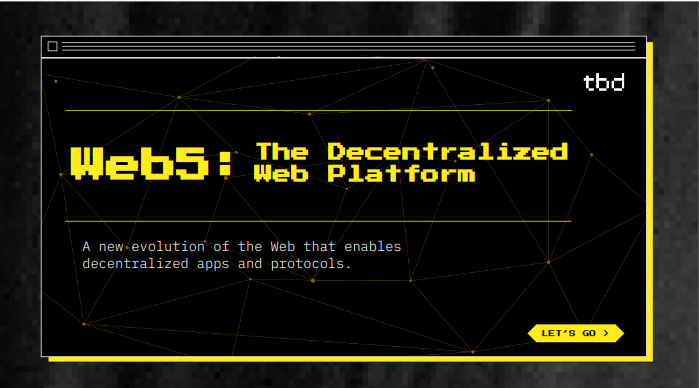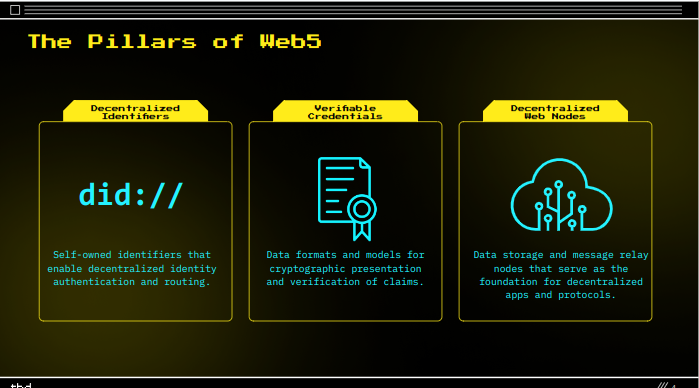WEB 5: The Ultimate Decentralized Web Platform
 Yusuf Sheriffdeen
Yusuf Sheriffdeen
Prioritizing Data Ownership and User Privacy
What is Web5?
Web5 is a decentralized peer-to-peer (P2P) network and platform developed on the Bitcoin blockchain, designed to support decentralized apps (dApps) and protocols. Simply put, it is a platform that empowers users with control over their data and identity. It differs from web3 as it incorporates the limitations of web3 and combines them with the features of web2 to offer true decentralization. How does it work?
Key Pillars of Web5:

1.Decentralized Identifiers (DIDs)
DIDs are novel, globally unique identifiers that empower users to take charge of their identity. The unique identifier of users is linked to their data through the Decentralized Web Node (DWN). By doing so, users' data is disconnected from centralized storage. Users will have complete control over their data, allowing developers to concentrate on creating the best user experience without concerns about storage.
2. Verifiable Credentials (VCs)
Verifiable credentials are digital credentials that are digitally signed and cryptographically secured to ensure tamper-evident properties. They surpass merely being digital versions of physical credentials by providing significantly enhanced efficiency, speed, and security in issuance and verification. Verifiable credentials enable the immediate generation and issuance of new credentials, which can then be presented by holders to organizations or individuals for verification. They are employed to validate various facets of an identity, affirming capabilities, credibility, and reputation. This emphasizes the prioritization of Data Ownership and User Privacy.
3. Decentralized Web Nodes (DWNs)
DWNs constitute highly connected networks of nodes responsible for locating public or private information associated with users through their decentralized identifiers (DIDs). As a user, you have the capability to host your personal data completely independently from any app you use, thereby maintaining complete control over your data, as these apps require your permission to access it. With decentralized Web Nodes, a user's data can synchronize to the same state across multiple nodes, facilitating easy and secure management of their data while communicating with other users, apps, or services, without relying on location-specific infrastructure or routing mechanisms. Decentralized web apps are constructed upon decentralized Web Nodes and decentralized identifiers.
4. Decentralized Web Apps (DWAs)
DWAs can be thought of as decentralized "progressive web apps." In contrast to traditional apps, they can be initiated without a server because data is stored on DWNs. Developers can concentrate on crafting exceptional user experiences while DWNs manage data storage.
Importance and Examples of DWAPs
The Web5 technology ecosystem, built upon the blockchain, helps reduce fraud, improve privacy, and assist with data management. Web5 is termed the "Emotional Web," fostering direct interaction between peers with their devices, also known as an intercommunity web. It expands creativity, enhances e-commerce communication, and provides users with control over their identity and data. Web 5.0 draws inspiration from Bitcoin, aiming to offer the benefits of decentralization and cryptographic security through blockchain technology.
Use Cases of Web5
1. Voting App
Indeed, a decentralized voting app can be developed on blockchain platforms, ensuring elections that are transparent, secure, and resistant to tampering. This approach fosters trust in the democratic process, as it leverages the inherent features of blockchain technology to uphold the integrity of electoral procedures.
2. Traveling App
By leveraging decentralized technologies, a travel app can empower users with increased control over their data, streamline transactions through smart contracts, and elevate security and privacy in the overall travel experience. This innovative approach enhances the user's ability to manage and protect their personal information while fostering efficiency in travel-related transactions.
3. Healthcare Management App
Constructing a healthcare management app on a decentralized infrastructure ensures paramount priorities such as data integrity, patient privacy, and interoperability among healthcare providers. This approach leads to more efficient and patient-centric healthcare services by providing a secure and interconnected environment that enhances the quality of patient care while preserving the confidentiality of sensitive information.
Quick Start
/
To get started with Web5, install the @web5/api from npm. Import the Web5 object, connect to the Web5 instance, and use it to access other objects like did and dwn.
import { Web5 } from '@web5/api';
const { web5, did: aliceDid } = await Web5.connect();
you’re able to write records in the user's Decentralized Web Node(DWN).
A DWN is a personal data store - a platform for messages, pictures, videos, medical records, and just about any content a user may want to store.
const { record } = await web5.dwn.records.create({
data: 'Hello, Web5!',
message: {
dataFormat: 'text/plain',
},
});
Visit the TBD website for practical examples.
Conclusion
Web5 holds immense promise as the next frontier in the evolution of the World Wide Web. Although still under development, the vision and potential of Web5 are captivating. With a focus on empowering users, ensuring control over identity and data, incorporating emotional intelligence, enhancing communication in e-commerce, and providing the security offered by blockchain technology, Web5 aspires to revolutionize our online experiences.
Subscribe to my newsletter
Read articles from Yusuf Sheriffdeen directly inside your inbox. Subscribe to the newsletter, and don't miss out.
Written by
